Antibody affinity purification resin solutions

1. Background
◆ Protein A is a surface protein in the cell wall of Staphylococcus aureus, which is composed of five homologous Ig-binding domains folded into triple helix bundles;
◆ Protein G is a protein in the cell wall of G and C streptococcus;
◆ Protein A/G is a recombinant protein A protein G fusion protein, which fuses 5 Fc binding domains from protein A and 3 Fc binding domains from protein G.
◆ Protein L is derived from Streptococcus macropepatia and binds to immunoglobulins through L-chain interaction.
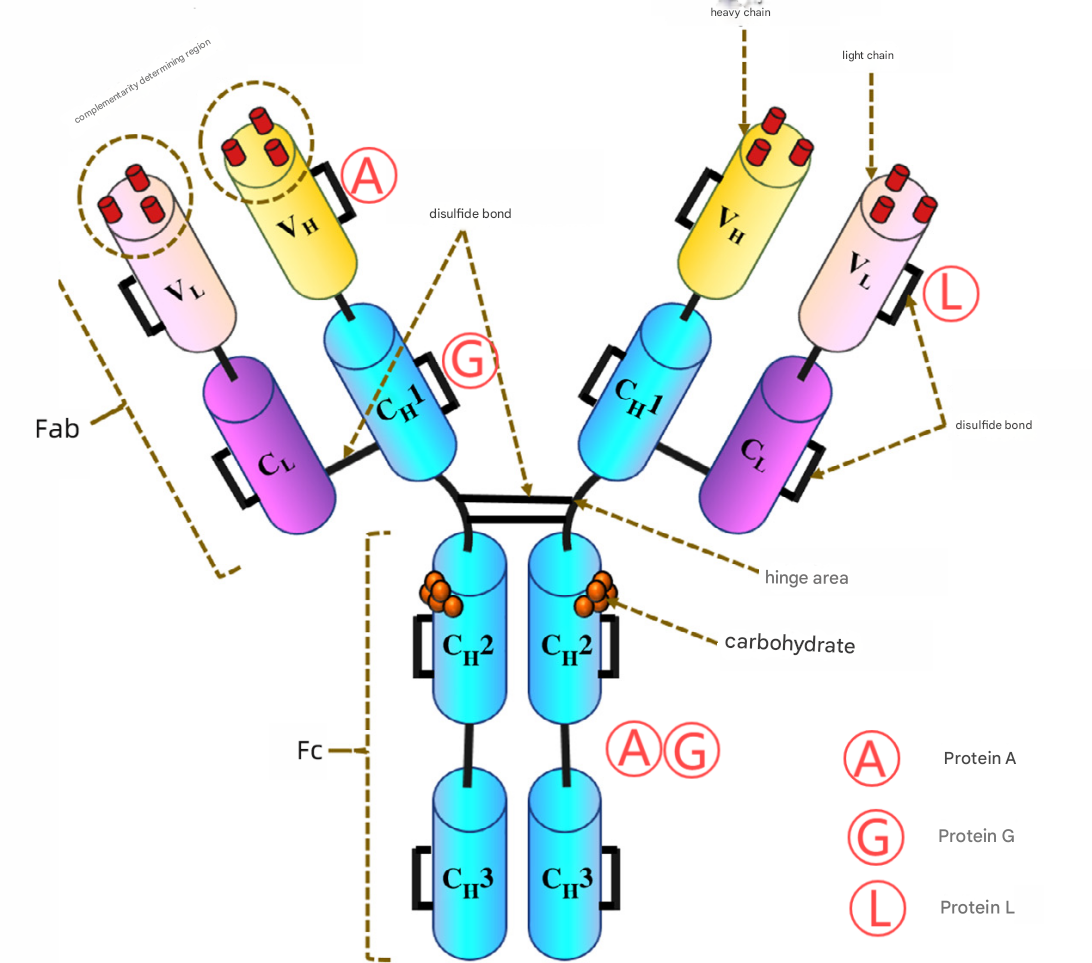
Fig.1 Region of action of antibody and antibody affinity ligand
Table 1 Antibody affinity differences of proteins A, G, and L
|
|
Protein A |
Protein G |
Protein A/G |
Protein L |
|
merit |
The binding site is in the Fc region between the CH2 and CH3 domains, and the heavy chain within the Fab region of the human VH3 family
|
It can specifically bind to the Fc segment of the immunoglobulin IgG molecule without affecting the ability of the Fab segment to bind to the antigen molecule |
It can bind to all human IgG isoforms, IgA, IgE, and IgM. Protein A/G reduces pH dependence and allows binding at pH 5-8 |
Binds only to the kappa light chain of the antibody without affecting the antigen binding site of the antibody. It can bind to a wider range of antibody classes, such as human IgG, IgM, IgA, IgE, IgD, as well as antibody fragments such as Fab and scFv containing kappa light chains (human type 1, 3, 4, mouse type 1). |
|
shortcoming |
|
|
Cannot bind to mouse IgA, IgM, and serum albumin |
Does not bind bovine, goat, or sheep derived immunoglobulins |
|
apply |
The field of purification, fixation, or detection of immunoglobulins |
Isolation and purification or removal of IgG from serum, purification of monoclonal antibodies, isolation of antigen-antibody complexes, etc |
Extraction and detection of murine IgG monoclonal antibodies |
Purification of monoclonal antibodies from culture medium supplemented with BSA or FCS is also widely used for purification and isolation of genetically modified engineered antibodies |
Table 2 Affinity between antibody affinity ligands and antibodies from different sources and subtypes
|
class |
Subtype |
Protein A |
Protein G |
Protein A/G |
Protein L |
|
person |
IgG1 |
+++ |
+++ |
+++ |
+++ |
|
IgG2 |
+++ |
+++ |
+++ |
+++ |
|
|
IgG3 |
+ |
+++ |
+++ |
+++ |
|
|
IgG4 |
+++ |
+++ |
+++ |
+++ |
|
|
IgM |
+ |
- |
+ |
+++ |
|
|
IgD |
- |
- |
- |
+++ |
|
|
IgA |
+ |
- |
+ |
+++ |
|
|
Fab |
+ |
+ |
+ |
+++ |
|
|
Mice |
IgG1 |
+ |
++ |
++ |
+++ |
|
IgG2a |
+++ |
+++ |
+++ |
+++ |
|
|
IgG2b |
+++ |
+++ |
+++ |
+++ |
|
|
IgG3 |
+++ |
+++ |
+++ |
+++ |
|
|
IgM |
- |
- |
- |
+++ |
|
|
Rats |
IgG1 |
+ |
++ |
++ |
+++ |
|
IgG2a |
- |
+++ |
+++ |
+++ |
|
|
IgG2b |
- |
+ |
+ |
+++ |
|
|
IgG2c |
+++ |
+++ |
+++ |
+++ |
|
|
cattle |
IgG1 |
+ |
+++ |
+++ |
- |
|
IgG2 |
+++ |
+++ |
+++ |
- |
|
|
goat |
IgG1 |
+ |
+++ |
+++ |
- |
|
IgG2 |
+++ |
+++ |
+++ |
- |
|
|
horse |
IgG(ab) |
+ |
- |
+ |
NA |
|
IgG(c) |
+ |
- |
+ |
NA |
|
|
IgG(T) |
- |
+++ |
+++ |
NA |
|
|
rabbit |
IgG |
+++ |
+++ |
+++ |
+ |
|
pig |
IgG |
+++ |
+ |
+++ |
+++ |
|
dog |
IgG |
+++ |
+ |
+++ |
NA |
|
chicken |
IgY |
- |
- |
- |
- |
Note:- Indicates that it is not included; + indicates the winning combination; +++ indicates the wrong combination; NA means N/A or data is not available.
2. Parameters of antibody affinity purification resin
|
category |
Recombinant Protein A agarose gel FF |
Recombinant Protein G agarose gel FF |
Heavy basophosphate protein A agarose gel FF |
Protein A/G agarose gel FF |
Recombinant Protein L agarose gel FF |
|
matrix |
4% cross-linked agarose |
4% cross-linked agarose |
4% cross-linked agarose |
4% cross-linked agarose |
4% cross-linked agarose |
|
Ligands |
Recombinant Staphylococcus aureus protein A, ≥ 6 mg/mL |
Recombinant streptococcal protein G, ≥ 6 mg/mL, single-point conjugation |
Recombinant alkali-tolerant protein A, ≥ 6mg/mL |
Protein A protein G fusion protein, ≥ 6 mg/mL |
Recombinant macrodigested streptococcal protein L, ≥6 mg/mL |
|
Particle size rangea |
45-165μm |
||||
|
Average particle size |
~90μm |
||||
|
Dynamic binding capacityb |
≥40mg h-IgG/mL |
≥40mg h-IgG/mL |
≥45mg h-IgG/mL |
≥40mg h-IgG/mL |
≥ 40 mg k light chain h-IgG/mL |
|
Recommended workflow speedc |
60-300cm/h |
60-300cm/h |
60-300cm/h |
60-150cm/h |
60-300cm/h |
|
Maximum flow rate and pressured |
>900cm/h |
||||
|
Use pH |
3-10 (recommended working pH), 3-12 (short-term stable) |
3-9 (recommended working pH), 2-10 (short-term stable) |
3-10 (recommended working pH), 3-12 (short-term stable) |
3-10 (recommended working pH), 3-12 (short-term stable) |
2-9 (recommended working pH), 15 mM NaOH (CIP) |
|
Chemical stability |
Stable in the following solutions: commonly used aqueous phase buffer, 10-100 mmol/L NaOH, 6 mol/L guanidine hydrochloride, 70% ethanol. |
Stable in the following solutions: commonly used aqueous buffer, 6mol/L guanidine hydrochloride, 70% ethanol. |
Stable in the following solutions: commonly used aqueous phase buffer, 0.1-0.5mol/L sodium hydroxide, 6 mol/L guanidine hydrochloride, 70% ethanol, etc. |
Stable in the following solutions: commonly used aqueous buffer, 0.1-0.5mol/L sodium hydroxide, 6mol/L guanidine hydrochloride, 70% ethanol, etc. |
Stable in the following solutions: commonly used aqueous buffer, 6mol/L guanidine hydrochloride, 70% ethanol. |
Concentrate:
a: Microspheres with more than 90% volume in this particle size range;
b: DBC10% test conditions are: 10% flow-through, 6min residence time;
c: The recommended flow rate means that the flow rate can meet the use conditions of 2-6min residence time under most column heights, and it is not only within the flow rate range;
D: Maximum test flow rate at 10 cm column height.
3. Application Data
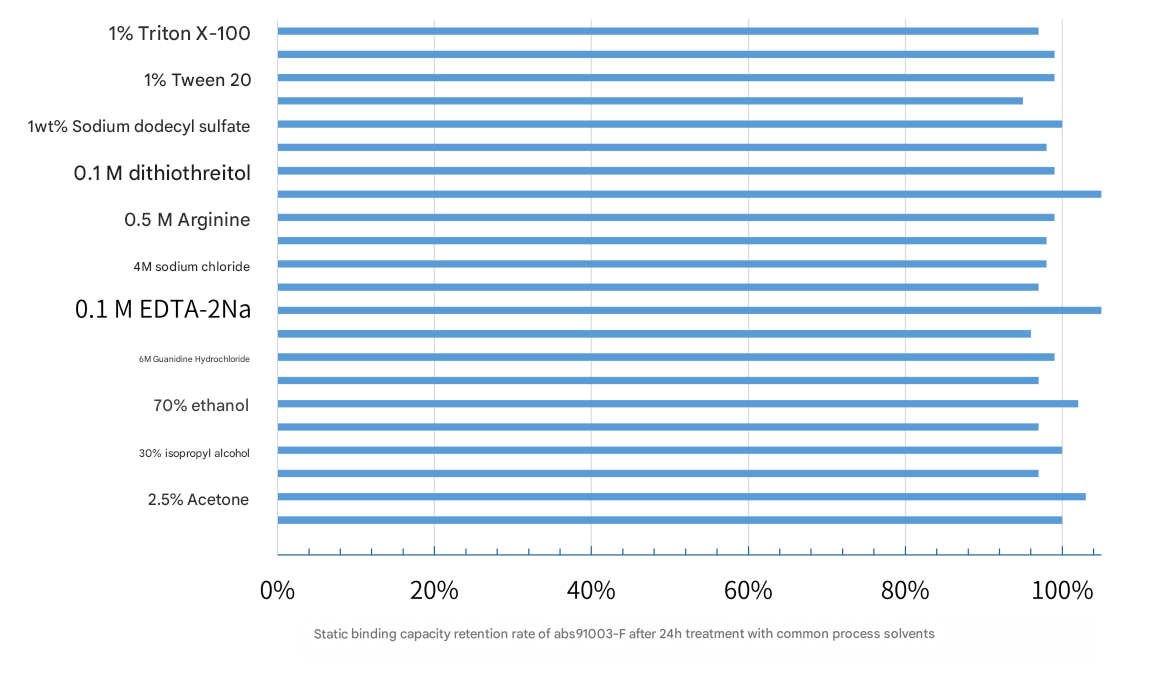
Fig.2 Process solvent stability
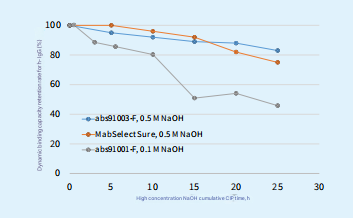
Fig.3 Tolerance of different protein A resins to NaOH
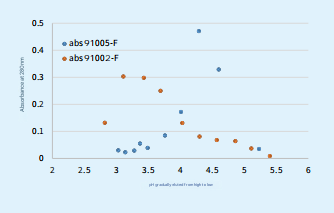
Fig.4 Elution curves of different protein G resins, the sample is H-IgG
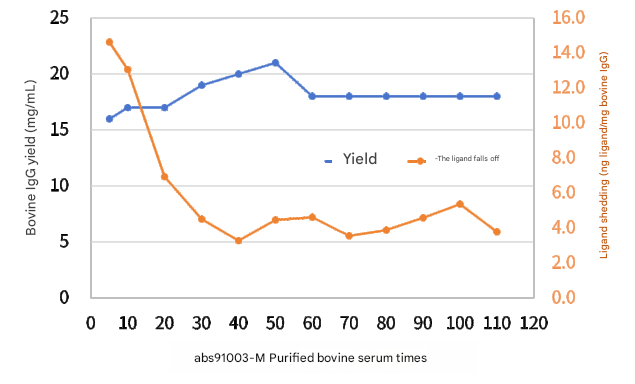
Fig.5. Resin: Heavy alkali-resistant protein A agarose gel FF (medium-pressure prepacked column) (Cat: abs91003-M);
Sample: Bovine serum, approx. 20 mg IgG/mL resin relative to resin;
Loading and binding buffer: 20mM PB, 150mM NaCl, pH7.4, 10CV;
Elution buffer: 100 mM glycine, pH 3.0, 14 CV;
Clean-in-place (CIP): 100 mM NaOH, 10 CV
Fourth, the product information of Absin antibody affinity purification resin
|
Catalog number |
Product name |
specification |
|
abs91001-F |
Recombinant Protein A agarose gel FF |
10mL/100mL |
|
abs91001-G |
Recombinant Protein A Agarose Gel FF (Gravity Prepacked Column) |
1mL/5mL |
|
abs91001-M |
Recombinant Protein A Agarose Gel FF (Medium Pressure Prepacked Column) |
1mL/5mL |
|
abs91002-F |
Recombinant Protein G agarose gel FF |
10mL/100mL |
|
abs91002-G |
Recombinant Protein G Agarose Gel FF (Gravity Prepacked Column) |
1mL/5mL |
|
abs91002-M |
Recombinant Protein G Agarose Gel FF (Medium Pressure Prepacked Columns) |
1mL/5mL |
|
abs91003-F |
Heavy basophosphate protein A agarose gel FF |
10mL/100mL |
|
abs91003-M |
Heavy Base-Resistant Protein A Agarose Gel FF (Medium Pressure Prepacked Column) |
1mL/5mL |
|
abs91003-G |
Heavy basophosphate protein A agarose gel FF (gravity prepacked columns) |
1mL/5mL |
|
abs91004-F |
Protein A/G agarose gel FF |
10mL/100mL |
|
abs91004-M |
Protein A/G Agarose Gel FF (Medium Pressure Prepacked Columns) |
1mL/5mL |
|
abs91004-G |
Protein A/G agarose gel FF (gravity prepacked columns) |
1mL/5mL |
|
abs91005-F |
Easy to elute Protein G agarose gel FF |
10mL/100mL |
|
abs91005-M |
Easy Eluting Protein G Agarose Gel FF (Medium Pressure Prepacked Columns) |
1mL/5mL |
|
abs91005-G |
Easy Eluting Protein G Agarose Gel FF (Gravity Prepacked Column) |
1mL/5mL |
|
abs91006-F |
Recombinant Protein L agarose gel FF |
10mL/100mL |
|
abs91006-M |
Recombinant Protein L Agarose Gel FF (Medium Pressure Prepacked Column) |
1mL/5mL |
|
abs91006-G |
Recombinant Protein L Agarose Gel FF (Gravity Prepacked Column) |
1mL/5mL |
References
[1] Arora S, Saxena V, Ayyar BV. Affinity chromatography: A versatile technique for antibody purification. Methods. 2017 Mar 1; 116:84-94. doi: 10.1016/j.ymeth.2016.12.010. Epub 2016 Dec 22. PMID: 28012937.
Absin provides antibodies, proteins, ELISA kits, cell culture, detection kits, and other research reagents. If you have any product needs, please contact us.
|
Absin Bioscience Inc. |
 Follow us on Facebook: Absin Bio Follow us on Facebook: Absin Bio |




